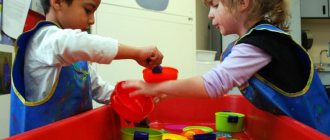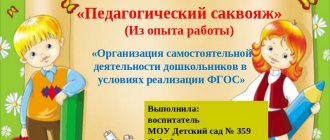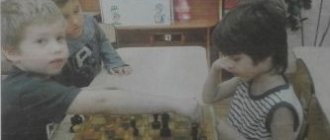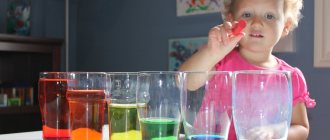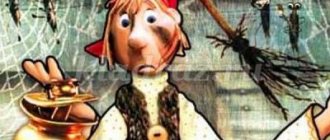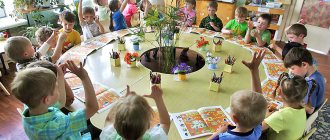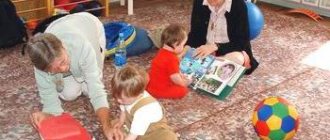Organization of independent activities in the preparatory group
The modern education system moves away from teaching children through direct transfer of knowledge, but develops in them the desire to search for new information using a variety of methods. The Federal State Educational Standard determines the areas of development of preschool children through the joint activities of the teacher and children. At the same time, the formation of the skill of independent activity is affirmed as the main feature of a successful personality. The teacher instills in the child the motivation to find answers to emerging questions, encourages curiosity, stimulates the development of imagination, a creative approach to problem solving and leisure activities. Independent children's activity is manifested in all types of activities of preschoolers:
- gaming (role-playing, didactic, logic games),
- artistic speech (creating dialogues in the game based on fairy tales, stories, constructing a retelling of an interesting incident or story),
- social-communicative (communication with peers, providing assistance to younger children - explanation of the phenomenon, rules of the game, consolation),
- cognitive-research (searching for information on a topic of interest, finding an answer empirically),
- artistic (singing, rhyming lines, composing melodies, drawing, modeling, creating appliqués),
- labor (desire to help clean the territory of the kindergarten, the dining room, group room, care for plants and animals).
Independent activity of preschoolers is most clearly manifested in the form of play
Independence is a personality trait characterized by the desire to solve problems of activity without help from other people, manifested in initiative, criticality, adequate self-esteem and a sense of personal responsibility for one’s actions.
Age characteristics of preschoolers 6–7 years old
When organizing the independent activities of students in the preparatory group, the teacher takes into account the age characteristics of children 6–7 years old:
- The ability to self-regulate behavior. Older preschoolers have greater perseverance; they are able to independently plan the pace and quality of practical activities so as to avoid overwork. During walks, in science and nature centers, the children conduct long-term observations. Children in their seventh year of life feel the need to change activities: they switch from looking at books to playing, from exercising with a ball to drawing, etc. To restore their emotional state, children have the opportunity to retire for the required period of time.
- High level of development of dialogical speech, formation of monologue speech skills. Older preschoolers actively participate in the conversation, ask questions, and formulate answers. The degree of development of artistic and speech skills allows you to act out dialogic scenes and theatrical episodes of fairy tales at your leisure. The skill of monologue speech is formed when a child accompanies research or play activities by pronouncing actions and voicing characters. He tells the teacher and classmates about the progress and results of independent work.
- Creativity. Older preschoolers often make spontaneous decisions and complete tasks in unexpected ways. A creative approach is observed in various types of children's activities: in oral stories, composing stories based on visual material, in drawings and crafts, during games, during experiments and experiments.
- Formation of self-esteem skills. By the age of seven, a child begins to realize the level of his capabilities, abilities and knowledge. He critically evaluates the results of his activities, his appearance, and is able to correct shortcomings in order to look better.
Older preschoolers independently help younger ones master self-care skills
Independent activity of children in a preschool educational institution implies its implementation without the direct participation of a teacher in a specially designated time, while preschoolers set specific goals for themselves, make efforts and strive for certain results.
Tasks of organizing independent activities in the senior group
Creating conditions for independent activity of older preschoolers in preschool educational institutions is aimed at solving a number of problems:
- Formation of strong-willed qualities: psychological resistance to the influence of external factors (street noise, voices of other children) and other people’s opinions, the desire to bring the plan to the final result. Older preschoolers begin to develop the ability for self-analysis and evaluation of completed actions.
- Improving self-regulation processes: the ability to calculate energy expenditure to perform planned actions, feel the need to change the type of activity or rest. At the age of 5–6 years, the processes of the nervous system actively develop: the child becomes more diligent, reacts positively to advice and constructive comments.
- Development of the ability to independently construct a game plan, observation, research, employment, the desire to implement ideas without the help of adults. Fostering friendly relations between students during games.
- Formation of sociocultural competencies through role-playing games (“Bank”, “Shop”, “Library”).
- Strengthening self-care skills. The actions of dressing and undressing, observing the rules of personal hygiene and cleanliness of the room should be brought to automaticity.
- Development of independence through fulfilling work assignments. Fostering a conscientious attitude towards the duties of duty officers.
Children 6–7 years old are able to independently occupy themselves while walking for a long period of time
Methodology for organizing independent activities
Despite the fact that independent activity is carried out outside the interaction of children with the teacher, the role of the teacher remains significant. He predicts possible options for pupils’ actions depending on the children’s subject environment, their abilities, individual characteristics and in accordance with calendar and thematic planning.
Techniques for organizing independent activities of preschoolers:
- creation of a rich, accessible and safe subject-spatial environment,
- formation and consolidation of practical and mental skills in classes as part of the educational process,
- creating internal motivation for independent activity.
The subject-spatial environment for independent activity of preschoolers is organized in kindergarten in the form of centers/corners of various directions:
- Cognitive centers: thematic corners for searching for new knowledge, research corners and laboratories for children's experimentation.
- Art centers: corners with visual materials on types of art, exhibitions of folk arts and crafts.
As a rule, art centers have a work space (table or desk) and materials for students’ productive creativity.
- Artistic and aesthetic centers: theater and music corners. Contains scenery, costumes, masks, sets for puppet and finger theater, musical instruments.
- Nature and environmental education centers: living corner, winter garden, ecology center. Older preschoolers not only observe plants and animals, but also take care of them. In ecology centers, experimental activities can be carried out to develop ideas about methods of purifying water, soil, air, children get acquainted with natural and industrial filters.
- Motor activity center. Equipment for physical exercises and sports games is stored here.
- Psychological comfort center: silence zone, relaxation corner. Sofas and armchairs, tents, a magic tent, pillows and ottomans - here children relax, engage in quiet activities (looking at books, cards, quiet games and conversations).
Theatrical role-playing game is an excellent option for organizing children's leisure time
The expansion of knowledge and the formation of practical and mental skills is carried out in classes conducted as part of the joint activities of the teacher and students. The accumulated experience of productive activity, the learned rules for conducting cognitive experiments and sports games are implemented in the child’s independent activities. Thus, in GCD classes, children master the principles of constructing a work plan and develop the ability to conduct experiments with various objects. In classes with a music director, they learn to control their voice, sing melodies, and extract sound from instruments (drum, tambourine, rattle, rattle, bell, pipe).
The head of physical education conducts a lot of outdoor games with the children, including the use of sports equipment (balls, jump ropes, hoops, skittles), the children remember the movements and sequence of exercises. Classes on the development of speech and communication create in preschoolers a desire to communicate within a group: ask questions, think about the answer, pronounce the stages of performing any actions, build logical chains of reasoning, and also develop the ability to monologue speech.
During walks, children carry out targeted observations together with the teacher of objects of the natural world (animals, birds, insects) and processes of social life (observation of the behavior of pedestrians, traffic on the roadway, the work of people of various professions). In classes on productive creative activity, students develop the ability to create crafts according to their own ideas using various techniques (modeling, design, drawing). In the preparatory group, a special place is occupied by classes on FEMP and preparation for learning to read and write: children learn to determine the composition of numbers and the sound composition of a word, learn in a playful way addition and subtraction within ten, vowels and consonants.
Photo gallery: examples of organizing a subject-spatial environment
Thematic exhibitions of materials and children's works are organized at the educational activity center
In the corner of the future schoolchildren, children can strengthen their counting skills and knowledge of the alphabet
An educational center for the study of books and illustrations promotes a caring attitude towards printed publications
The art center contains visual materials for the artistic and aesthetic development of preschool children and materials for productive activities
In the living corner of the kindergarten there may be aquariums with fish, snails and turtles, cages with birds and rodents
There must be a place in the group room where the child can retire and relax
Children often complement theatrical scenes with musical accompaniment.
In a corner of nature, children watch the growth of plants and study their features
A corner of independent experimentation in order to search for new knowledge allows children to realize their desire for experimental knowledge of objects and phenomena
Table: types of independent activities of older preschoolers
| Type of independent activity | Form of implementation in regime moments |
| Gaming | Game is the leading form of activity for preschool children; in the game, the child recreates a model of the world in all its diversity. The teacher of the preparatory group should not accustom children to the lesson form of classes; it is advisable to preserve the play form of acquiring new knowledge and developing abilities until the end of their studies in kindergarten. Children of the seventh year of life independently act out scenes from fairy tales, cartoons, stories, or everyday situations with the help of toys. The play activities of preschoolers are often imitative of people’s professions and social events: “Library”, “Pedestrian crossing”, “On the bus”, “Grocery store”, “Newsstand”, “Bank”, “Playing in kindergarten or school” " These games develop the child’s ability to interact with other people in various life situations (social competencies are formed). |
| Research | The research abilities of older preschoolers are at a sufficient level to conduct long and labor-intensive experiments and observations. A child of the seventh year of life identifies a problematic issue for himself, ponders hypotheses, speculatively predicts the result, engages in practical experimentation and evaluates the result. The research activity of an older preschooler is as close as possible in structure to scientific research. |
| Artistic (including artistic and speech) | Artistic activity consists of creating images using creative abilities. In the crafts of older preschoolers, a plot appears, the attitude of the young author to the depicted object or phenomenon is clearly expressed. Techniques for productive creativity available to children aged 6–7 years:
One of the favorite forms of recreating the images of literary and fairy-tale characters is the theatricalization of a plot or a separate dialogue. Pupils love to try on roles, put on masks, costumes, and use face painting. Creating melodies using musical instruments and composing songs is also an option for independent creative activity. |
| Motor | Older preschoolers develop a competitive spirit. They independently organize small competitions for agility, endurance, strength: “Who can stand on one leg longer?”, “Who can run to the end of the section and back faster?”, “Jumping rope competition.” Physical activity is also carried out during work (clearing paths of snow, removing leaves in a wheelbarrow) and games (“Flying tacks”, “Cossacks-robbers”, “Hopscotch”, etc.). |
| Labor (including self-service) | When children see how adults work: a janitor cleans the territory of the kindergarten, teachers keep order in group areas, parents provide all possible assistance in repairing the premises and improving the street space of the preschool educational institution, participate in cleanup days and other labor actions, then they have the desire to independently monitor for cleanliness in the group and on the street to the best of their ability. Pupils of the preparatory group keep their locker, work and sleeping place in proper order, learn to perform the duties of duty officers, correct shortcomings in their own appearance and are ready to help younger children. Self-care skills are also reinforced through play (“Get the doll in order,” “Put it in its place”), and you can conduct game trainings with children 6–7 years old (for example, “Beauty salon: learning how to do hairstyles”). |
Through role-playing games, children acquire social competencies
Organization of children's activities
In the preparatory group, the modern pedagogical and educational system, although characterized by the transfer of knowledge, skills or abilities through training, at the same time, it is capable of developing in children such an important quality as motivation to independently search for the necessary information, including any responsible activity.
The main property by which the quality and effectiveness of schoolchildren’s development can be determined is upbringing and learning through the joint activities of the child and the teacher. At the same time, the skill of independent activity is formed, which is identified as the main aspect for creating a successful personality.
With a properly configured pedagogical process, the teacher develops in the preschooler the desire to search for answers to this or that question that interest him, and also encourages curiosity in every possible way.
The teacher also allows the child to improve creative skills, with the help of which he can better cope with everyday problems.
Children's activity, removed from the participation of the teacher, manifests itself in any type of activity, including gaming, artistic or educational. Social and communication skills also develop, which improves the personality of the future individual.
The main types of independent activities in the preschool group:
| Variety | Implementation form |
| Gaming | The game process is the basis of any child’s activity, in which he is able to recreate a model of the external environment based on his creative abilities. It is especially important for the teacher to maintain play activity, which is well used in the educational process. So, children can act out various fairy tales, discuss stories or any other situations using toys. Play activities also improve the preschooler’s ability to interact correctly with other children or adults. |
| Cognitive | Research skills in the older group are most often at a good level in order to conduct independent experiments or observations. Thus, a preschooler can think about certain hypotheses, identify a question of interest, or predict the result in a particular case. It is interesting that the child’s research practice is as close as possible to the scientific approach. |
| Art and speech | An artistic activity is to create an interesting image using certain creative skills. Older schoolchildren can express various subjects in their fakes, while investing in them a hidden meaning or morality. Children use modeling, drawing with paints or pencils, and construction using various materials. Often a favorite form of interaction is the theatricalization of a specific plot or fairy-tale character. Therefore, children love various costumes, masks or face painting, which allows them to plunge into a fairy-tale world. |
| Motor | In this case, preschoolers independently organize various motor exercises, can draw up a schedule for implementation, and also learn performance techniques. The child also develops a competitive spirit, which is effective not only during physical activity, but also in life. |
| Labor | If children observe how a janitor works, a cook prepares food, and how a teacher maintains order in a kindergarten, they unconsciously try to imitate adults, which increases their sense of self-confidence and responsibility for a specific task. In this case, self-service skills also develop. |
Of all the above methods of organization, the most effective is the game type, which is present in absolutely all the described techniques.
At the same time, the teacher cannot abandon others in favor of a specific one, because only with the help of an integrated approach can the best results in education and upbringing be obtained.
Self-care lesson in the preparatory group of kindergarten
A child of seven years of age improves and consolidates self-care skills. He follows the rules of eating, skillfully handles cutlery, and maintains cleanliness and neatness. Knows the sequence of dressing for a walk, knows how to handle different types of fasteners. Takes care of the order of personal belongings and his appearance. This is how a child ideally graduates from kindergarten - an independent person. At the beginning of the school year, the teacher should monitor the level of independence of all students. If difficulties in performing any actions or insufficient development of one of the skills are identified, the teacher takes corrective measures.
Older preschoolers love to care for indoor plants on their own
Pupils in the preparatory group understand the teacher's instructions and follow verbal instructions. The main form of strengthening self-service skills in children 6–7 years old is work assignments: “We need to collect snow in the right place so that the janitor can fill the slide for us,” “Wipe the window sills with a damp cloth, please,” “Help the nanny put the fruit in a vase.” For the children of the preparatory group, a list of duties in the dining room, bedroom, and corner of nature is compiled.
The introduction of duties for cleaning and monitoring the condition of the premises disciplines the children, instills in them respect for the work of others and responsibility in carrying out assignments.
Duty activates the work activity of children and evokes a sense of pride in their work
Table: card index of topics on self-care in the preparatory group
| Self-Care Topic | Developmental and educational tasks | Options for work assignments as the main method of motivating students |
| "Duty roster" |
|
|
| “Keeping shoes and clothes, sleeping place, work tools, etc. in order.” |
|
|
| "Rules of personal hygiene" |
|
|
| "Spring-cleaning" |
|
|
Self-care and hygiene skills are reinforced in the preparatory group
Photo gallery: examples of organizing a duty corner
The duty schedule for kindergarten students should be clear
The distribution of duty officers according to areas of responsibility develops various self-service skills in children.
The duty officers' corner can be decorated in an interesting way
Aprons and hats must be prepared for those on duty in the dining room.
The duty officers' corner should be a pleasant place; performing work duties is not a routine
Motivating start to class
Independent activity of preschoolers begins with the emergence of a motive - interest in a topic, the emergence of a problematic situation, a desire to communicate with peers. Practical actions are carried out using the child’s existing knowledge and abilities. The result of the activity is assessed by the pupil of the preparatory group; he tells the teacher about the implementation of experiments and research, improving his speech skills.
The role of the teacher is to create motivation for further actions of students in the conditions of the subject-spatial environment organized by the teacher. Interest in independent activity can be playful, communicative, creative, or cognitive in nature. The teacher makes sure that a friendly atmosphere is maintained in the group and that each student has a positive, even emotional background.
The teacher creates interesting situations, predicting the independent activities of students within the framework of thematic planning and the individual characteristics and preferences of the children.
The plot game reflects the new knowledge of pupils and helps to fix it in the form of images of long-term memory
Table: examples of a motivating start to a lesson
| Option for a motivating start to the lesson | Predicted independent activity of pupils |
| Conducting cognitive and heuristic conversations. — Guys, where are the dishes stored at your home? — In the kitchen: in cupboards and on shelves. — Does your mother put clean dishes in the closet mixed together? - No. There are drawers with compartments for cutlery, shelves for pots and pans, hanging shelves for cups and plates, hooks for a ladle, colander, vegetable peeler, etc. - Why does mom put the dishes on the shelves in this order? — That it’s easy to find the item you need. Every thing has its place! — What other categories of objects, besides dishes, should be placed in their designated places? - Shoes - in the shoe rack, clothes - in the wardrobe, books and magazines - in the bookcase, writing instruments - in the desk drawers. |
|
| Studying visual material. The teacher invites the children to study the model of the solar system: how many planets are there, what size they are, what features are noticeable (craters, mountain peaks, clouds, rings, the presence of satellites). |
|
| Creating a problematic situation. The group receives a letter from Dunno. He writes that he recently dropped a coin into the river and it drowned. Since then, Dunno has been tormented by the question: “Why did a small metal coin sink, but large metal ships do not sink?” |
|
| Attraction to the game. The teacher brings a set for playing small towns to the physical education center and asks the children if they remember the rules. | Collective discussion of the rules of the game, outdoor game. |
| Reading during leisure time the fairy tale “The Three Little Pigs.” |
|
Reading literary works encourages games and dramatizations of fairy-tale plots
Lesson time plan
Educational and training tasks of developing and consolidating self-service skills are implemented in ECD classes, the duration of which in the preparatory group is no more than 30 minutes. Educational classes have a structure consisting of various forms of work to attract the interest of students and prevent fatigue. It is recommended to include work assignments in routine classes that are not dedicated to educational activities themselves (walking, leisure).
Table: examples of temporary lesson plans on different topics
| Lesson topic | Organizational moment | Motivating start | Development of thinking abilities | Physical activity | Practical work | Summarizing |
| "Book Repair" | 1 minute | Creating a problematic situation. Dunno comes to the group and reports that he was suspended from classes in the first grade. The children ask what happened. Dunno answers that at home he and his friends played war games and fired back at imaginary enemies with shells from textbooks. At school, the teacher saw that the covers of the textbooks were torn off, the pages were torn, and told the careless student not to come to class until he learned how to properly handle books. 4 minutes. | Conducting a conversation about caring for books. 4 minutes. | Physical education 4 minutes. | Repairing damaged books in the library corner: gluing pages, repairing covers. 15 minutes. | 2 minutes. |
| "Big Wash" | 1 minute | Inclusion in a game situation. The teacher invites preschoolers to collect dolls to play with children from another group. While the children are collecting dolls, the character Chumazik runs into the room and dirty the doll's clothes. 4–5 minutes. | Conducting a conversation about the need to maintain neatness and cleanliness. Talking through the procedure for washing clothes (the children got acquainted with this on a preliminary excursion to the laundry). 4 minutes. | Outdoor games “Doll plays ball”, “Tumbler doll”. 4 minutes. | Washing doll clothes, hanging the washed clothes on the clothesline. 15 minutes. | 1 minute. |
Washing doll clothes is fulfilling a work assignment in a playful way
Table: example of a lesson summary on developing self-service skills in a preparatory group
| Author | Gordienko M.K., teacher at MBDOU D/s No. 48, Achinsk, Krasnoyarsk Territory. |
| Name | “Every thing has its place” |
| Program content |
|
| Equipment |
|
| GCD move | The teacher reads L. Voronkova’s story “Masha the Confused” to the children and conducts a conversation on its content:
Conversation about order. The teacher asks questions:
Children: We put the toys away, hang the clothes in the locker, put them on the high chair before going to bed, put the shoes on the shelf, set the table, remove the glasses from the table after eating. V.: Well done, everyone is attentive and helps maintain order in the group! We will now go on a tour of the group and see if all the things are in place. If someone does not put the toy back in its place, then the toys may become offended and hide from you. The teacher approaches the sports corner and asks the children to name what is missing. (Spins and ball). The teacher approaches the music corner with the children and asks them to name what is missing. (Drum, in the art activity corner - coloring books). V.: You see, children, many things have been hidden. But I will tell you who will help you find them. You know this hero. This is Brownie, he lives in every house and knows everything that happens in it. The teacher shows the children Brownie, pays attention to his appearance and says that he is kind, attentive, caring, and in his hands he has a bag in which there may be missing toys. V.: The little brownie wants to play with you. Game "Wonderful bag". The teacher calls one child at a time and asks them to take any item out of the bag. The child takes out the object, names it and takes it to its place. After the game, the teacher talks with the children:
V.: You know where each of the things should be. But in every group and home there are many small items and they should also have their place. Brownie suggests playing the game “Every thing has its place.” There are many small items on the table: sewing supplies, pencils, ribbons, hairpins, elastic bands, decorations for dolls and boxes, boxes, baskets, cups. The teacher asks one of the called children to find a place for each item. After the game, he rewards the children with stars for their help. |
In a playful way, children reinforce the skill of storing things in their proper places
Examples of independent activities of children in the preparatory group
We invite you to familiarize yourself with the options for independent activity of preschoolers 6–7 years old at various regime moments.
Video: independent activities of children in preschool educational institutions (cognitive, playful, communicative)
Video: independent activity (example of employment by activity centers)
Video: role-playing game “In the clinic”
Video: organizing independent creative activities (musical and theatrical direction)
The basis for the harmonious development of the personality of a future first-grader is the manifestation of independence. In a playful way, the child learns self-care skills, develops abilities for research and experimentation, exhibits physical activity, communicates with peers, and creates. The organization and monitoring of independent activities of older preschoolers in kindergarten should be given close attention.
Motivating start to class
The independent activity of children in the preparatory group begins with the creation of a main motivator - interest in a certain topic, solving a problem, or the desire to communicate with other preschoolers.
Actions of a practical nature can be carried out based on the child’s own skills or abilities.
The immediate result of learning is assessed not only by the teacher, but also by the preschooler, so he talks about his own experience and observations to the teacher. This also allows you to develop your communication skills even more effectively.
The main role of the teacher is aimed at creating the necessary motivation for the actions of preschoolers , which he organizes based on the subject or spatial environment of a particular group. Such interest in activities can have both a playful and creative, cognitive nature.
The teacher must create interesting cases within the framework of a specific plan in order to predict the student’s independent work in relation to a certain topic, as well as based on the individual characteristics of the preschooler.
The motivating beginning should be characterized by an increase in interest in learning itself , which is best developed through gaming activities. Various games, performances or any other creative aspects are well integrated into any task: from cognitive and creative, to motor or labor.
